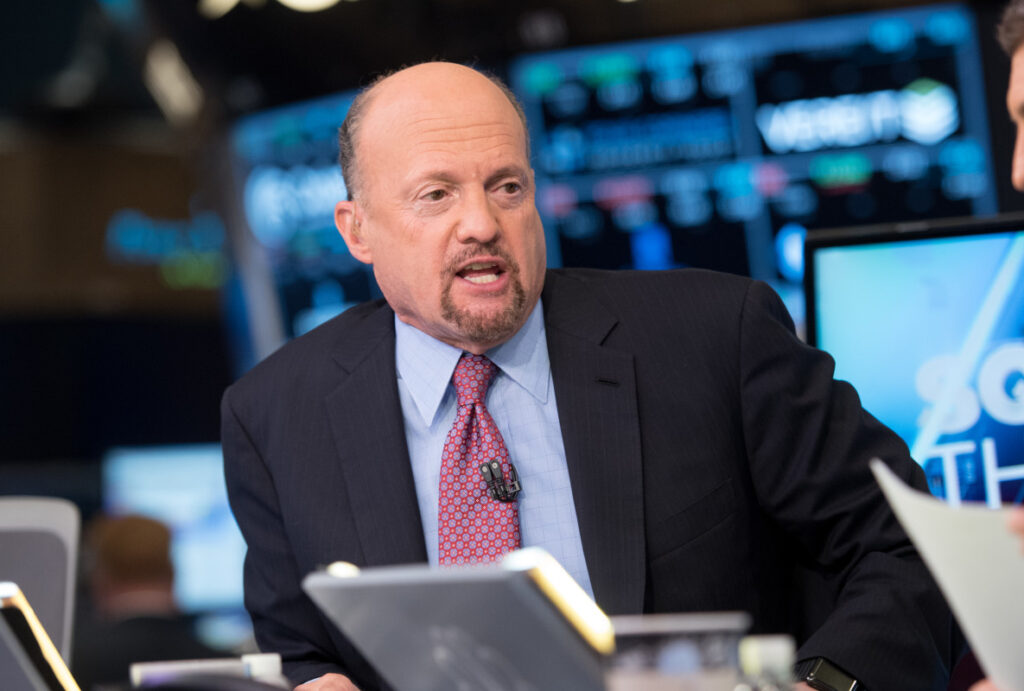Markets are typically conditioned to believe bad economic news is good for stocks.
However, Friday’s jobs report, which showed just +22,000 payroll additions and the highest unemployment rate in nearly 4 years, pushes that belief too far.
Surprisingly, with rate-cut odds surging (96% chance of a Federal Reserve interest rate cut of 0.25% on September 17), the stock market pulled back anyway. The S&P 500 dipped 0.3%, while banks dropped even harder.
That’s where veteran analyst Jim Cramer stepped in to challenge the mantra he’s repeated for years.
If lower rates can’t lift growth or shield earnings, we’re looking at something deeper under the surface.
Accordingly, Cramer’s tone has shifted, and the market took notice.
Image source: Noam Galai/Getty Images
S&P 500 rally looks strong, but concentration risk is rising
After blowing through to fresh record highs on September 4, the index dipped 0.3% the next day on the back of a weak jobs print, souring risk appetite.
Nevertheless, year-to-date gains sit near an impressive 10% — solid, but increasingly concentrated and valuation-rich.
Related: Goldman Sachs issues high-stakes Apple stock forecast
Consequently, the markets are leaning hard toward a 0.25% cut on Sept. 16-17 (odds at over 90%), with only a modest chance of a 0.50% cut following the payrolls miss. Hence, policy support is likely to come, but with a softer growth backdrop.
Here are some of the S&P 500’s highlights this year:
- Gains: Up 10.2% year-to-date through September 5; still near all-time highs despite Friday’s dip.
- Concentration risk: “Magnificent 7” hovers around a startling one-third of the index value; Nvidia is at 8% alone.
- Valuation remains elevated: Forward price earnings ratio is at 22.4 times, above 5-year (19.9) and 10-year (18.5) averages.
- Earnings engine: Wall Street sees 10.6% EPS growth in 2025; Q3 2025 is at over 7.5%, which would mark a ninth straight year-over-year EPS gain.
It seems that 2025’s theme is “intact but mostly top-heavy,” and if the Fed eases as priced, the next leg likely turns as earnings deliver against those heavy multiples.
S&P 500 faces real risk, says Jim Cramer, as bad labor news hits harder
Jim Cramer feels it’s apt to rethink Wall Street’s favorite mantra.
On the latest edition of CNBC’s “Mad Money,” he reminded viewers of the old adage: When the economy shows cracks, stocks win because the Fed steps in.
“On Wall Street, we’ve all been conditioned to believe that good news is bad news and vice versa,” he said.
Related: Major analysts reset Google stock price target after DOJ antitrust win
However, this time Cramer isn’t buying it. The Sept. 5 labor report was so troubling that he thinks the usual rate-cut tailwind probably won’t be enough.
“Sometimes bad news really is bad news,” he warned. “We got something so weak…it feels like even lower rates won’t resuscitate things.”
Markets seemed to agree.
The Dow turned lower by over 200 points, with bank stocks leading the proceedings. Cramer linked the sluggishness to the potential risk that “corporate earnings may be coming down, and credit…might get tighter, leading to rising defaults.”
More News:
- Jim Cramer says this red-hot health care stock still has plenty of room to run
- AI stocks face a reality check after a $1.5 billion implosion
- Amazon’s bombshell move triggers a high-stakes AI turf war
Data backing Jim Cramer’s take on labor market:
- Jobs shock: August nonfarm payrolls came in at +22,000 with unemployment at 4.3% (near 4-year high); average hourly earnings (AHE) rose by +0.3% month-over-month and +3.7% year-over-year, while the average workweek held at 34.2 hours.
- Market read: S&P 500 declined 0.3% Sept. 5; S&P bank index dropped 2.4% as investors priced in cuts but feared the growth/credit situation.
- Housing baseline is weak: Existing-home sales came in at 4.01 million units on a seasonally adjusted annual rate (SAAR) basis in July 2025, hovering near multi-decade lows following 2024’s 4.06 million (lowest since 1995).
Related: Billionaire Ray Dalio makes hard-hitting call on economy




